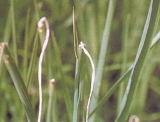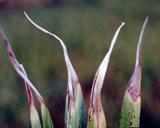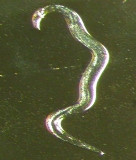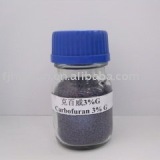|
White Tip Nematode
| Symptoms |
|
| |
|
- This nematode is widely distributed in Tamil Nadu
- Feeding at leaf tips in rice results in whitening of the top 3-5 cm of the leaf, leading to necrosis known as "White Tip".
- Tips of developing leaves become twisted and crinkled.
- Diseased plants are stunted, lack vigor and produce small panicles.
- Affected panicles show high sterility, distorted glumes and small and distorted kernels. In extreme cases the affected grains become chaffy.
- When nematode carrying seeds are sown, the immature forms become active, move up the plant along a thin film of moisture and feed on the foliage ectoparasitically.
|
 |
| Twisted and crinkled leaf tips |
 |
| Whitening and necrosis of leaf tips- white tip |
|
| Top |
| |
Identification of pest |
|
|
 |
- Aphelenchoides besseyi is best known as the causal agent of white tip disease of rice.
- It is a facultative ecto- and endoparasite of the leaves and young tissues of rice.
- The nematode is seed borne and can survive in a state of anhydrobiosis for several years on stored grain, but much less under field conditions.
- Reproduction is usually amphimictic, the life cycle taking 8 days at 23° C.
- It is characterized by a large metacorpus (median bulb), and esophageal glands usually overlapping dorsally.
- Ithas a slender body 0.44-0.84 mm long and 14-22 μm wide.
- In females, the excretory pore is usually near the anterior edge of the nerve ring.
- Male reproductive structures have no bursa and the spicules.
|
| Aphelenchoides besseyi |
 |
| White tip nematode |
| Top |
| Management Strategies |
|
- Resistant varieties such as TPS 1, TPS 2 can be grown.
- Presoaking overnight and sun drying for 12 hours at 6 hrs/day for two days, two or three days prior to sowing to denematize the seeds.
- Hot water treatment of seed with 52 -53 degree C for 15 minutes can be used to destroy this nematode infecting the seeds.
- Apply carbofuran 3G in nursery @ 1.0 kg a.i/ha 7 days before transplanting.
- Apply cartaphydrochloride @ 1.0 kg a.i/ha at 45 DAT
- Aphelenchoides besseyi infestations can be avoided by using nematode-free seeds and planting in nematode-free planting material.
- Destruction of infected source of inoculum like seeds,weeds,debris left after harvest in field
- Chemical treatments of seed with Benomyl or Thiabendazole is being effective in controllingnematodes.
- Spraying of infested crop with Parathion (.025%) and Trichlorophos (0.03%) three times has been found to be effective.
|
 |
| Chemical seed treatment with benomyl |
 |
| Apply Carbofuran |
| Top |
|






